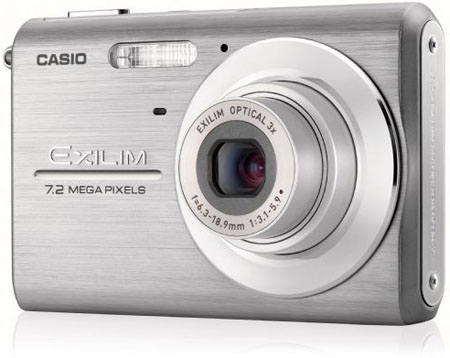This article is more than 1 year old
Casio Exilim EX-Z75 and EWC-10 underwater case
Diving with a digicam
Review How do you sell a seven-megapixel camera when so many rivals are doing the same? You can't rely on the usual features - big LCD, anti-blur tech, slimline metal casing, etc - because everyone else has those too. No, you need something a little different, and in Casio's case that means offering your latest compact camera with an optional underwater kit.

The camera itself is the Exilim EX-Z75, and it's a lovely looking compact. It's decked out in two-tone brushed metal and is thin enough to be eminently pocketable or danglable - there's a rotating lanyard attachment on the side - but not so thin it feels like it won't withstand the rigours of a holiday. The design is very much all smooth lines, scoring point instantly with everyone at Register Hardware.
The controls are laid out in a straightforward manner and well thought-out. Apart from the power key and the shutter button on the top, they're all on the back, to the right of the large, 2.6in, 479 x 240 LCD in ready reach of your right thumb. From top down you have the standard zoom keys; two buttons to switch between picture viewing and picture taking; a circular five-way navigation control with Set in the middle; and, next to each other, Menu and Best Shot buttons.
The standard viewfinder display positions the image on the left and settings - picture resolution, flash, timer, sensitivity and so on - in a strip down the right. You select them by moving the nav control up or down - as each icon is highlighted, a horizontal panel pops out displaying icons for the available settings, including Auto. The settings default to automatic, but this layout makes it easy to apply specific settings when you need to, without have to move from one shooting mode to another.
For young kids and folk who really don't want to be bothered with options, there's an Easy mode, selected with an icon that looks like a four-leaf clover. Selecting it reduces the options to image size, flash mode and timer. Choosing any of these, or pressing the Menu key, pops up a full-screen panel with comments to illuminate the icons.
Push Menu in the standard mode, and you get options listed under three tabs - Rec, Quality and Set Up - each of which stretch up to three screens full of items. Unlike the main user interface, it's not the easiest of UIs to navigate - you can't quickly hop from a setting under, say, Set up, to one in Rec, for example - but then it's a place you go occasionally rather than every time you want to take some shots.
